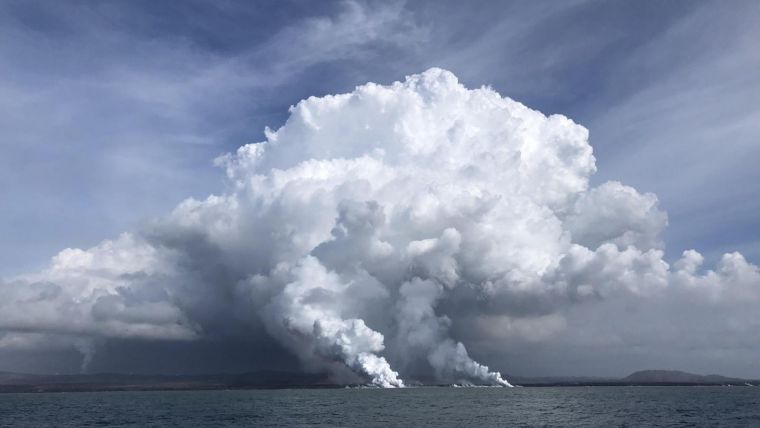Kīlauea Lava Fuels Phytoplankton Bloom off Hawaii Island
When the Kīlauea volcano erupted in 2018, it injected millions of cubic feet of molten lava into the nutrient-poor waters off the Big Island of Hawaii. The lava-impacted seawater contained high concentrations of nutrients that stimulated phytoplankton growth, resulting in an extensive plume of microbes that was detectable by satellite, as research of the School of Ocean and Earth Science and Technology (SOEST) shows.
A study led by researchers at the University of Hawaii (UH) in Mānoa and University of Southern California (USC) and published in the Science journal revealed that this biological response hinged on unexpectedly high concentrations of nitrate, despite the negligible amount of nitrogen in basaltic lava. The research team determined that nitrate was brought to the ocean surface when heat from the substantial input of lava into the ocean warmed nutrient-rich deep waters and caused them to rise up, supplying the sunlit layer with nutrients.
Rapid Response Oceanographic Expedition
After observing the phytoplankton bloom in satellite images, the UH Mānoa Center for Microbial Oceanography: Research and Education (C-MORE) organized a rapid response oceanographic expedition on UH research vessel Ka‘imikai-O-Kanaloa from July 13 to 17, 2018—in the thick of Kilauea’s activity. The team conducted round-the-clock operations in the vicinity of the lava entry region to test water chemistry and the biological response to the dramatic event.
Co-lead authors Sam Wilson at C-MORE and Nick Hawco, a USC researcher who will be joining the UH Mānoa Oceanography Department in January 2020, tested the hypothesis that lava and volcanic dust would stimulate microorganisms that are limited by phosphate or iron, which are chemicals found in lava.
Heated Seawater Became Buoyant
As it turned out, since there was so much lava in the water, the dissolved iron and phosphate combined into particles, making those nutrients unavailable for microbes. Further, deep, heated seawater became buoyant and brought up nitrate which caused other classes of phytoplankton to bloom.
It is possible that this mechanism has led to similar ocean fertilization events in the past associated with the formation of the Hawaiian Islands and other significant volcanic eruptions, the authors suggest. Depending on their location, sustained eruption on this scale could also facilitate a large flux of nitrate from the deep ocean and perturb larger-scale ocean circulation, biology and chemistry.
External Nutrients Alter Marine Ecosystems
“The expedition in July 2018 provided a unique opportunity to see first-hand how a massive input of external nutrients alters marine ecosystems that are finely attuned to low-nutrient conditions,” said Wilson. “Ecosystem responses to such a substantial addition of nutrients are rarely observed or sampled in real-time.
"UH has a strong tradition of not only volcanic research but also looking at its impacts on the surrounding environment such as the ocean, groundwater, and atmosphere. This latest piece of research improves our understanding of lava-seawater interactions within the much broader context of land-ocean connections.”
Unique, Interdisciplinary Project
“Science is a team sport,” said Dave Karl, senior author and co-director of the UH Mānoa Simons Collaboration on Ocean Processes and Ecology (SCOPE). “SCOPE emphasizes collaboration, where scientists with complementary skills came together to complete this unique, interdisciplinary project.”
In the future, the team hopes to sample the newly-formed ponds at the bottom of the Halema‘uma‘u crater and further investigate lava-seawater interactions in the laboratory.
Photo: Kilauea lava entry site on the southeast coastline of Hawaii. Billowing plumes of laze caused by the interaction of hot molten lava and seawater are visible (credit Karin Bjorkman, UH).














